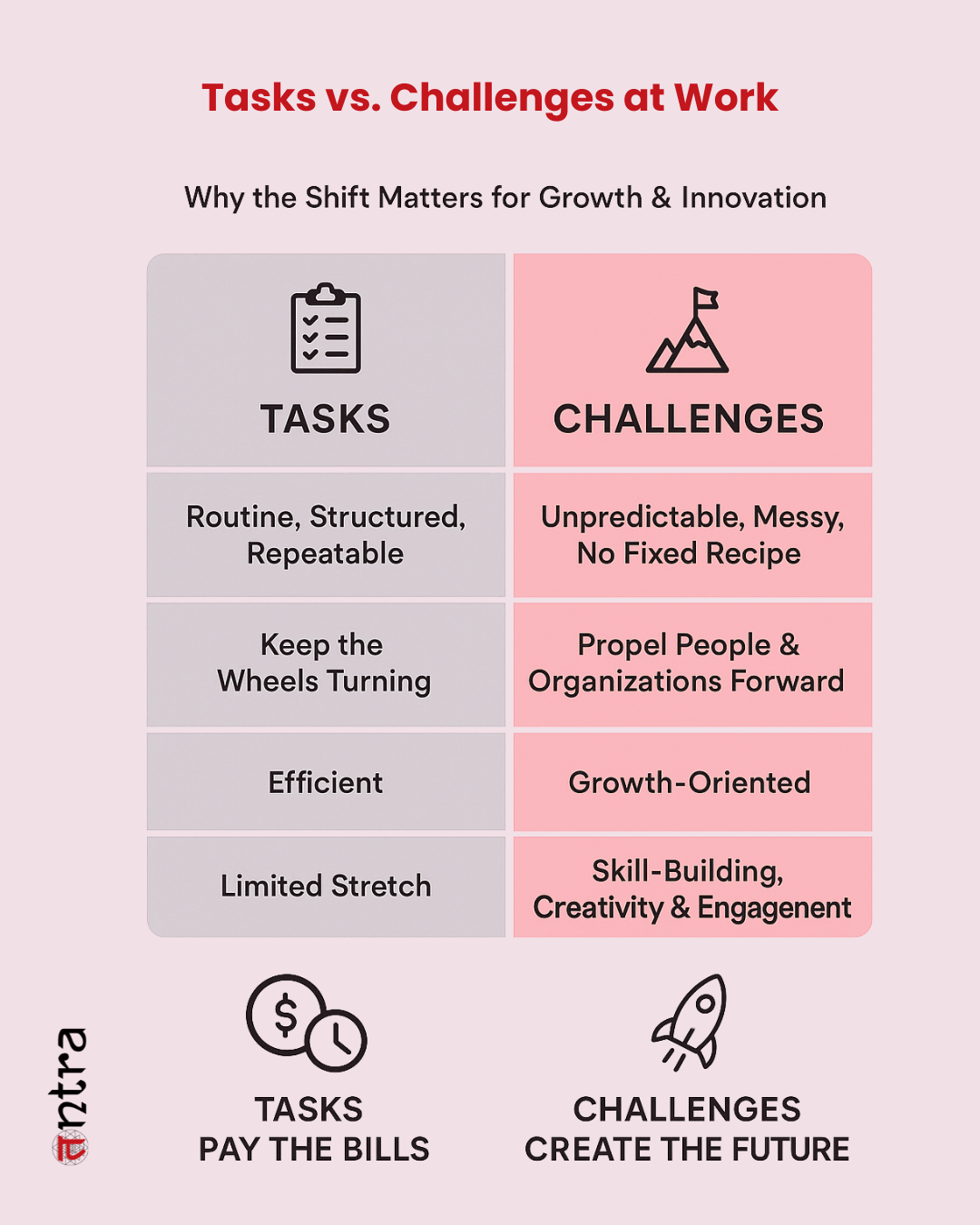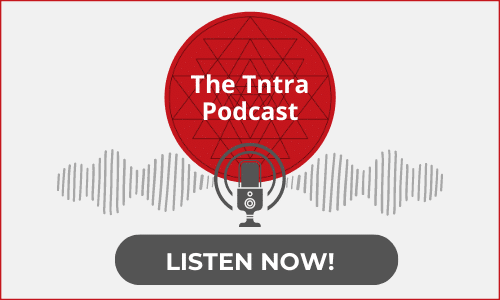
Tasks vs. Challenges: A New Way to Grow at Work
Table of Contents
ToggleIf you look at most jobs today, growth tends to be defined in terms of numbers: tasks done, hours worked, deadlines achieved. It’s safe, quantifiable, predictable. But I have to ask you – does checking off tasks really cause people to grow?
Not much.
Tasks keep the wheels of business turning. Challenges, on the other hand, propel people and organizations forward. And in today’s world of change, that distinction makes a bigger difference than ever before.
Tasks vs. Challenges: What’s the Real Difference?
On the surface, both sound similar – you’re doing work, applying effort, delivering results. But they create completely different outcomes.

Tasks are routine. They’re clear, structured, and repeatable – like submitting reports, processing orders, or responding to support tickets. They keep the wheels turning, but they rarely stretch anyone.
Challenges stretch. They’re unpredictable, usually messy, and do not accompany a recipe. Consider spearheading a cross-functional project, repairing a busted customer experience, or identifying a new source of revenue when sales are declining.
Tasks are efficient. Challenges are growth-oriented.
Why Leaders Should Care About the Difference
Here’s the reality: most performance reviews and advancements remain dependent on task completion. But if you only reward tasks, you create teams that are effective – but not adaptable, innovative, or inspired.
On the other hand, challenges light people up. They create excitement, engagement, and that sense of “I’m doing something meaningful here.” People don’t get a dopamine rush from finishing a checklist. They get it when they crack a tough problem or try something new that actually works.
That’s why growth-minded leaders must ask: “What challenges are my people enduring, and how am I assisting them in thriving through them?”
What Happens When You Make Challenges a Priority
As soon as you begin to make challenges an integral part of daily work, several fundamental things start happening:
1. People become more creative.
If you say, “Launch a campaign,” they will rummage through old playbooks. If you ask, “Double leads in a shrinking market,” new ideas start to pop.
2. Teams get flexible.
Markets change. Customer needs shift. Tech advances. If your team is habituated to challenges, they’re already adapted to deal with uncertainty. They don’t panic; they problem-solve.
3. Talent remains.
High performers don’t hang around for the ordinary. They hang around for challenges that challenge them, educate them, and provide them with stories they can be proud of.
From Tasks to Challenges: What Leaders Can Do
So how do you change the culture from a task-focused one to a challenge-focused one?
- Redesign roles
Rather than “submit quarterly reports,” frame it as “redesign reporting so leaders can make quicker decisions.” Same job, but with a very different effect.
- Make room for safety risks
If failure is a career assassin, individuals won’t take a chance. Create an environment where intelligent experiments are okay to take, even if they don’t all pan out.
- Transfer ownership, not commands
Assignments typically have step-by-step instructions. Challenges do not. When you say, “Here’s the result we require – create the pathway,” individuals step up to the challenge.
- Identify the stretch, not merely the finish line
Don’t just celebrate completed checklists. Celebrate bold thinking, creative problem-solving, and the lessons people are learning – even if everything didn’t go exactly right. That’s where real growth occurs.
Real-Life Examples
Retail chain rethinking digital
A struggling retailer with diminishing foot traffic didn’t simply task “boost online sales by 10%.” They defined the mission: “Put 40% of our sales online in one year.” The added urgency prompted teams to work together, try new technologies, and rethink customer interaction. They didn’t only achieve the goal – they created new channels for growth.
IT company retaining top talent
A medium-sized IT firm saw engineers departing to startups. Rather than assigning them more tasks, the leadership initiated “Challenge Week,” in which workers submitted and worked on new ideas. Participation soared, turnover decreased, and a few of those ideas translated into revenue-generating services.
For Individuals: Stop Hiding Behind Tasks
This isn’t about leadership – it’s personal as well. Employees have the choice to remain in the comfort of tasks or venture into the development of challenges.
Ask yourself:
- Am I performing primarily predictable work, or work that challenges me?
- Have I recently engaged in something that was uncomfortable yet exhilarating?
- Do I finish my week with only tasks done – or new skills acquired?
- If the response tilts toward challenges, perhaps it’s time to request (or design) more work.
Conquering the Fear Factor
Everyone inevitably procrastinates. Following are the typical arguments and why they fall short:
“We don’t have time.” In reality, challenges usually clarify processes in the long run. The immediate stretch avoids future headaches.
“Not everyone wants challenges.” That’s true, but most individuals crave significance. If challenges are positioned as meaningful, individuals lean in.
“What if they don’t work out?” Then they learn. Every failed challenge adds data, skills, and confidence for the next one.
The Future of Work is Challenge-Driven
As AI and automation do repetitive tasks, the true value of human work is creativity, adaptability, and problem-solving. And those only come from challenges.
The leaders that will succeed will be those that cease measuring individuals by the number of tasks that they check off – and begin building spaces where challenges are daily fuel for development.
Closing Thought
Tasks pay the bills. Challenges create the future.
As a leader, the question isn’t: “How many tasks did my team accomplish this week?“
It’s: “What challenges did they embark on – and how did those challenges cause them to grow?“
Answer it well, and you won’t only have productive workers – you’ll have leaders for the future.
Make Work More Engaging and Impactful – Request a Demo Now!
FAQs
How can I, as an employee, ask my manager for more challenges without sounding like I’m avoiding my core responsibilities?
Frame it as a desire to grow. Say you’re excited to take on new challenges in addition to your current work, not instead of it. This shows initiative, not avoidance.
What’s the difference between a difficult task and a challenge?
A difficult task may just be hard or unpleasant. A challenge, on the other hand, is engaging, it stretches your skills, sparks curiosity, and often feels worth the effort.
How can a small business with limited resources introduce a challenge-driven culture?
It starts small. Give team members autonomy, let them experiment, and reward creative problem-solving. You don’t need big budgets to make work feel meaningful.
What is the difference between tasks and challenges in the workplace?
Tasks are things you have to do. Challenges are things you get to solve. One checks boxes; the other fuels motivation and learning.
Why are challenges important for career growth?
Because that’s where the real learning happens. Challenges build skills, confidence, and visibility — all of which open the door to bigger opportunities.
Can completing tasks alone lead to professional growth?
Not really. Tasks keep the engine running, but challenges are what stretch you. Growth comes when you push past what you already know how to do.




